March is often the beginning of spring at Hoyt Arboretum. Buds burst all over the park, but the flowering tree collections on the east side of Fairview are a must-see this time of year. For the clearest signs of spring we recommend Magnolia Tail, the Winter Garden, Wildwood Trail between Magnolia and Hawthorn Trails, Maple Trail, and Overlook Trail.
Winter Weather
Winter weather like snow and ice can occur in March at the Arboretum (but hopefully not!!). Plan ahead and check our Recent Updates page for information about Visitor Center and park road closures resulting from unsafe conditions. Otherwise, make sure you dress for the weather before your visit! Wear layers and shoes that can get muddy!
Coming Up at Hoyt Arboretum


Tree Planting Basics April 5, 2025 at 10:00 am – 12:30 pm
Common Spring Mushrooms with Leah Bendlin April 6, 2025 at 10:00 am – 12:30 pm
Forest Bathing April 6, 2025 at 1:00 pm – 3:30 pm
Spring Mushroom Discovery Walk with Leah Bendlin April 6, 2025 at 1:30 pm – 3:30 pm
Flowering Trees Walk April 12, 2025 at 10:30 am – 12:30 pm
Healing Herbs of the Arboretum April 13, 2025 at 10:30 am – 12:30 pm
Introduction to Mushroom ID April 18, 2025 at 1:00 pm – 3:30 pm
Forest Bathing April 18, 2025 at 3:00 pm – 5:00 pm
Grief-focused Forest Bathing April 19, 2025 at 9:30 am – 12:00 pm
Pop-Up Nature: Spring Break 2025
March 24 – 28
10am – 12pm
in the Visitor Center
4000 SW Fairview Blvd
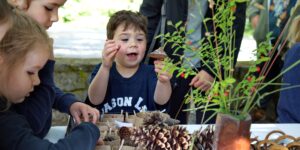

When PPS and many Portland-area schools are out for spring break, it also happens to be a wonderful time to explore nature at Hoyt Arboretum! Each day there will be an exploration station with an educator ready to share a new nature topic with you!
Hands-on activities and fun facts will help youth connect with the trees, flowers, and animals found throughout the Arboretum. Activities are designed for ages 3-8, but all are welcome!
Stop by any time! These events are free and do not require registration.
Trees to See and Plants to Peruse!
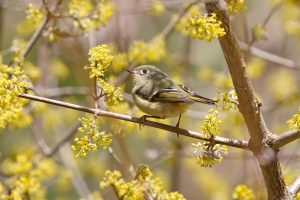

Cornelian cherry
This is one of the “big three” early-flowering shrubs (the others being witch hazel and forsythia). The dense masses of small yellow flowers attract lots of bees in the early season. The berries arrive later in the summer and are often described as being like a combination of cranberry and sour cherry. Fun fact: The wood of this plant is so dense that it doesn’t float. The ancient Greeks crafted weapons from the wood.
Location: Vietnam Veterans Memorial
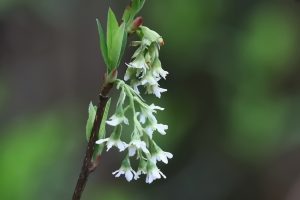

Indian plum or osoberry
The greenish-white, five-petaled, almond-scented flowers of this large native shrub appear in late winter, before its leaves. The species name refers to its fruit being in the shape of a cherry (cerasiformis). When red-purple and fully ripe, the fruits are edible, but you’ll have to beat the birds, squirrels, and coyotes to them. The common name osoberry indicates that bears (oso in Spanish) also enjoy the berries. New leaves may have the scent or flavor of cucumber.
Location: Oak Trail
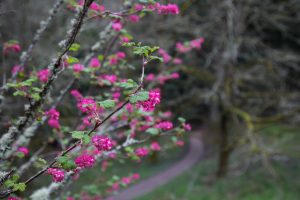

Red-flowering currant
The pink to bright red flowers of this Northwest native are the source of its species name sanguineum (“blood red”). In Oregon and Washington, it can be found mainly on the west side of the Cascade Mountains. The flowers emerge early in spring and have a resinous scent. They attract hummingbirds and butterflies. In the fall, blue-black berries appear and are a favorite of songbirds. Botanical sources describe the berries as “palatable but insipid,” so best to leave them “for the birds.”
Location: Trail side in many locations, particularly along Overlook Trail near the main parking lot.
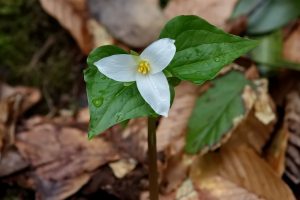

Pacific Trillium
One of the most recognizable plants of the Northwest forest floor, Pacific trillium, a member of the lily family, is notable for its bright white flowers that fade to pink or purple late in their life cycle. The name trillium refers to the plant parts that come in groups of three—the petals, the sepals below the flower, and the leaves. Trillium is very slow to develop, taking up to seven years to flower for the first time.
Location: Once they start blooming, you’ll see them all over the Arboretum’s Trails! A favorite spot: the Fairy Forest (Norway spruce collection between Spruce Trail and the start of the Fir Loop).
Stay Up-To-Date with Hoyt Arboretum!
Subscribe to our email newsletter
AND
